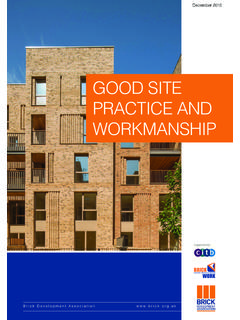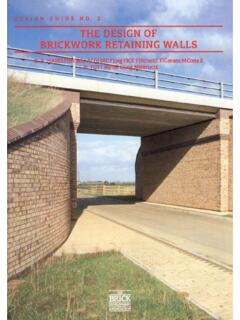Transcription of 3. Lateral resistance - Brick
1 How to design masonry structures using Eurocode 6. 3. Lateral resistance Revision 2. Eur Ing, Prof. J J Roberts BSc(Eng), PhD, CEng, FIStructE, FICE, FIMS, FCMI, MICT O Brooker BEng, CEng, MICE, MIStructE. Guidance for Lateral resistance Introduction This publication is part of a series of three guides This guide is the third in a series of three giving guidance on the design of entitled How to design masonry structures using masonry structures to Eurocode 61. The first guide, Introduction to Eurocode 62. Eurocode 6. The aim is to make the use of gives an introduction to design and assessment of actions using Eurocode 6.
2 Eurocode 6, Design of masonry structures as easy as and also covers the specification and workmanship of masonry. The second possible by drawing together in one place key guide in the series3 covers the design of vertically loaded masonry. This guide information and commentary required for the explains how to design for horizontal actions. Throughout this guide the design of typical masonry elements. Nationally Determined Parameters (NDPs) from the UK National Annexes (NAs) have been used. These enable Eurocode 6 to be applied in the UK. The Concrete Centre (and, originally, The Modern Masonry Alliance) recognised that effective guidance was required to ensure that the UK.
3 Eurocode 6 methods for Lateral design profession was able to use Eurocode 6. quickly, effectively, efficiently and with confidence. resistance Therefore a steering group, with members from Eurocode 6 offers two approaches to the design of laterally loaded panels. The across the masonry industry (see back cover for a first method relies on the flexural strength of the masonry and makes use of list of members), was established to oversee the yield line analysis to provide bending moment coefficients. The second method development and publication of the original guides.
4 Is an approach based on arching and the assumption of a three-pinned arch being formed within the wall. Both methods are presented in this guide. This second revision addresses the publication of PD6697 in 2010 and revised National Annex to The flexural strength approach is the most widely used and does not depend BS EN 1996-1-1 in 2013. It was overseen by a upon rigid supports to resist arch thrust. In the UK, the reliance on the reconstituted steering group from industry (see development of tensile strength in the masonry has meant that this design back cover).
5 Approach has usually been limited to transitory loads only. Eurocode 6 indicates that the flexural strength of masonry should not be used in the design of walls subjected to permanent Lateral actions, gravity or reinforced retaining walls. The assessment of the edge conditions is a requirement for the flexural strength approach. A free edge is easily identified but some judgement on the part of the engineer is necessary in deciding between simply supported or fixed conditions. When considering the vertical support condition, attention also needs to be paid to the potential position of movement joints and the changes the provision of such joints make to the panel size and restraint conditions.
6 Where the walls are not rectangular, for instance a trapezoidal-shaped wall to a mono-pitched structure, engineering judgement may be applied to determine the effective wall height. Wall panels with openings need to be treated with care and may typically be sub-divided into smaller panels around the opening. It is beyond the scope of this guide to deal with the topic in detail and reference should be made to suitable handbooks4,5. Alternatively, a yield line analysis from first principles may be used; the guidance in Practical yield line design6 can be applied to wall panels.
7 How to design masonry structures using Eurocode 6. If a damp proof course (dpc) is present in a wall subjected to flexure 2 WEd l2 when the plane of failure is perpendicular to the bed MEd2 = a then the degree of fixity may be altered. The bending moment joints coefficient at a dpc may be taken as that for an edge over which full where continuity exists, provided that there is sufficient vertical load on the a1 = bending moment coefficient parallel to the bed joints dpc to ensure that the flexural strength capacity is not exceeded. (= a2, see Table 2). a2 = bending moment coefficient perpendicular to the bed Walls may be either horizontally and/or vertically spanning and the joints (see Table 2).
8 Ultimate strength of the wall is governed by the capacity of the WEd = design wind load per unit area (g Q Wk). masonry to resist flexural tension. This capacity is enhanced by the l = length of panel between supports presence of vertical load. Clearly the potential flexural strength is = orthogonal ratio (fxk1/fxk2). greater if the potential plane of failure is perpendicular rather than parallel to the bed joint. Lateral resistance using flexural strength The presence of a vertical load increases the flexural strength of a panel in Figure 1 shows a flow chart for Lateral load design.
9 The designer needs the direction parallel to the bed joints. The design moment of resistance to assess the panel support conditions (or assume a free edge) and within the height of the wall is given by: decide whether these provide simple or continuous (fully restrained) f MRd = gxk1 + s d Z. support. Care also needs to be exercised in considering the effect of M. dpcs, movement joints, openings in walls, etc. There are handbooks where that provide further guidance on these aspects4,5. fxk1 = characteristic flexural strength of masonry bending about an axis parallel to bed joints (see Table 1).
10 Bending moments using coefficients gM = appropriate partial factor for materials For panels without openings, the bending moments per unit length s d = design vertical load per unit area (< fk /g M). (MEd) are: Z = section modulus of the plan shape of the wall MEd1 = a1 WEdl2 when the plane of failure is parallel to the bed joints fk = characteristic compressive strength (see Vertical resistance3). Figure 1. Flow chart for the design of masonry walls to resist Lateral actions t Masonry unit properties Type and group Dimensions Strength h Obtain water absorption for clay masonry unit or Characteristic Lateral actions Determine requirements declared compressive for mortar strength and strength from durability.








